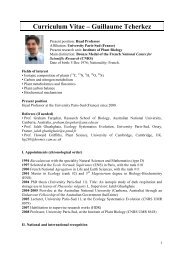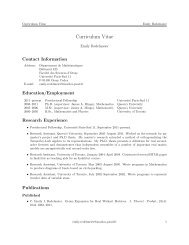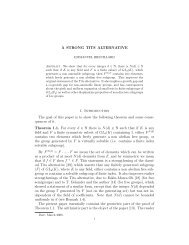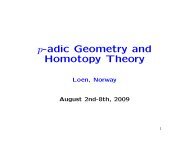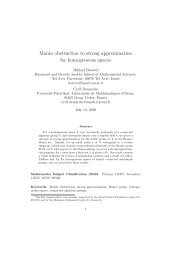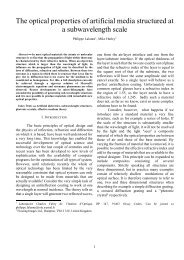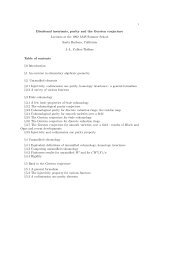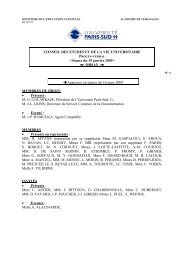feuille 5 de TD pour Maths1 (fonctions et courbes dans le plan)
feuille 5 de TD pour Maths1 (fonctions et courbes dans le plan)
feuille 5 de TD pour Maths1 (fonctions et courbes dans le plan)
You also want an ePaper? Increase the reach of your titles
YUMPU automatically turns print PDFs into web optimized ePapers that Google loves.
Fonctions <strong>de</strong> <strong>de</strong>ux variab<strong>le</strong>sExercice 14.— Tracer la courbe d’équation x 3 + y 3 = 3xy en la coupant par <strong>le</strong>s droites y = tx,<strong>et</strong> en faisant varier <strong>le</strong> paramètre t ∈ R.Exercice 15.— 1. Pour chacune <strong>de</strong>s formu<strong>le</strong>s suivantes, déterminer l’ensemb<strong>le</strong> <strong>de</strong> définition, <strong>et</strong><strong>de</strong>ssiner c<strong>et</strong> ensemb<strong>le</strong>.xy 22x+y , sin( 11−x 2 −y),ln(x − y),√ √ 2 √2x + y + 1, 2x + y + 1 ln(x − y), x2 + y 2 − 4,e1y+2x 2 ,√x2 + y 2 1− 4 × ey+2x 2 , ln(x 2 − y 2 ).⋆2. Déterminer <strong>de</strong>s formu<strong>le</strong>s <strong>pour</strong> <strong>le</strong>s dérivées partiel<strong>le</strong>s premières <strong>de</strong> chacune <strong>de</strong> ces <strong>fonctions</strong>.Exercice 16.— 1. Soit f 1 (x, y) = sin(x) + y 2 . Déterminer <strong>le</strong>s <strong>fonctions</strong> partiel<strong>le</strong>s <strong>de</strong> f en unpoint (x 0 , y 0 ). Tracer rapi<strong>de</strong>ment l’allure <strong>de</strong> <strong>le</strong>ur graphe, en indiquant notamment <strong>le</strong>s maxima <strong>et</strong>minima <strong>de</strong> la fonction.2. Mêmes questions <strong>pour</strong> f 2 (x, y) = sin(x)y.3. Mêmes questions <strong>pour</strong> f 3 (x, y) = exp(−x 2 − y 2 ). Quel<strong>le</strong>s sont <strong>le</strong>s lignes <strong>de</strong> niveau <strong>de</strong> f 3 ?Exercice 17.— Pour chacune <strong>de</strong>s <strong>fonctions</strong> suivantes f en <strong>le</strong>s <strong>de</strong>ux variab<strong>le</strong>s x <strong>et</strong> y, trouver <strong>de</strong>nouvel<strong>le</strong>s variab<strong>le</strong>s X <strong>et</strong> Y , <strong>fonctions</strong> linéaires en x <strong>et</strong> y, tel<strong>le</strong>s que f s’exprime en fonction <strong>de</strong> X<strong>et</strong> <strong>de</strong> Y sous une <strong>de</strong>s formes : XY , aX 2 + bY 2 , aY + bX 2 . Dans chacun <strong>de</strong>s cas, préciser l’allure<strong>de</strong>s lignes <strong>de</strong> niveau <strong>de</strong> f.1. f 1 (x, y) = x 2 + y 2 − 2xy + y + x2. f 2 (x, y) = 2x 2 + 5y 2 − 2xy3. f 3 (x, y) = 3y 2 − 2x 2 − 5xy4. f 4 (x, y) = 4x 2 + 7y 2 + 10xyExercice 18.— Pour <strong>le</strong>s <strong>fonctions</strong> suivantes, calcu<strong>le</strong>r <strong>le</strong>s dérivées partiel<strong>le</strong>s premières, donner <strong>le</strong>urva<strong>le</strong>ur au point indiqué <strong>et</strong> écrire la formu<strong>le</strong> <strong>de</strong> Taylor d’ordre 1. On justifiera rapi<strong>de</strong>ment que lafonction est <strong>de</strong> classe C 1 sur un voisinage du point considéré.1. f(x, y) = x sin(y) en (1, π/4) ;2. f(x, y) = tan(x 2 + y) en (0, 0) ;3. f(x, y) = arctan(y/x) en (2, 2) ;4. f(x, y) = √ x 2 + y 2 en (2, 2) ;5. f(x, y) = ln(1 + (x + y) 2 ) en (x 0 , y 0 ) ;6. P (V, T ) = k T V (où k est une constante) au point (V 0, T 0 )Exercice 19.— Pour chacune <strong>de</strong>s <strong>fonctions</strong> suivantes, calcu<strong>le</strong>r <strong>le</strong> DL à l’ordre 1 à partir <strong>de</strong>sDLs classiques <strong>de</strong>s <strong>fonctions</strong> d’une variab<strong>le</strong>. On vérifiera que <strong>le</strong> reste se m<strong>et</strong> bien sous la forme <strong>de</strong>‖(h, k)‖ɛ(h, k) où ɛ est une fonction <strong>de</strong> limite 0 en (0, 0).1. f(x, y) = e x−y en (0, 0) ;2. f(x, y) = (1 + x) √ 1 + y en (0, 0) ;3. f(x, y) = √ 1 + sin(x − y) en (0, 0) ;4. f(x, y) = 1+x1+yen (0, 0).Exercice 20.— La figure 5 est une carte du relief d’une presqu’î<strong>le</strong> : <strong>le</strong> contour extérieur est laligne <strong>de</strong> niveau 0 (bord <strong>de</strong> mer). L’équidistance <strong>de</strong>s lignes <strong>de</strong> niveau est <strong>de</strong> 25 mètres.Un plaisancier mouillant <strong>dans</strong> la baie située au sud <strong>de</strong> la presqu’î<strong>le</strong> voudrait franchir la presqu’î<strong>le</strong>à skis <strong>pour</strong> rejoindre la côte nord, en se dirigeant toujours droit vers <strong>le</strong> nord.1. Partie graphique Dessinez <strong>le</strong> profil du relief <strong>le</strong> long <strong>de</strong> trois itinéraires sud-nord, en évaluant<strong>pour</strong> chacun <strong>de</strong> ces itinéraires l’altitu<strong>de</strong> du point culminant. En quel point <strong>de</strong> la baie <strong>le</strong> plaisancierdoit-il abor<strong>de</strong>r <strong>pour</strong> que son dénivelé soit <strong>le</strong> plus p<strong>et</strong>it possib<strong>le</strong> ? Marquez sur la carte <strong>le</strong> pointculminant <strong>de</strong> son itinéraire, <strong>et</strong> évaluez-en l’altitu<strong>de</strong>.



